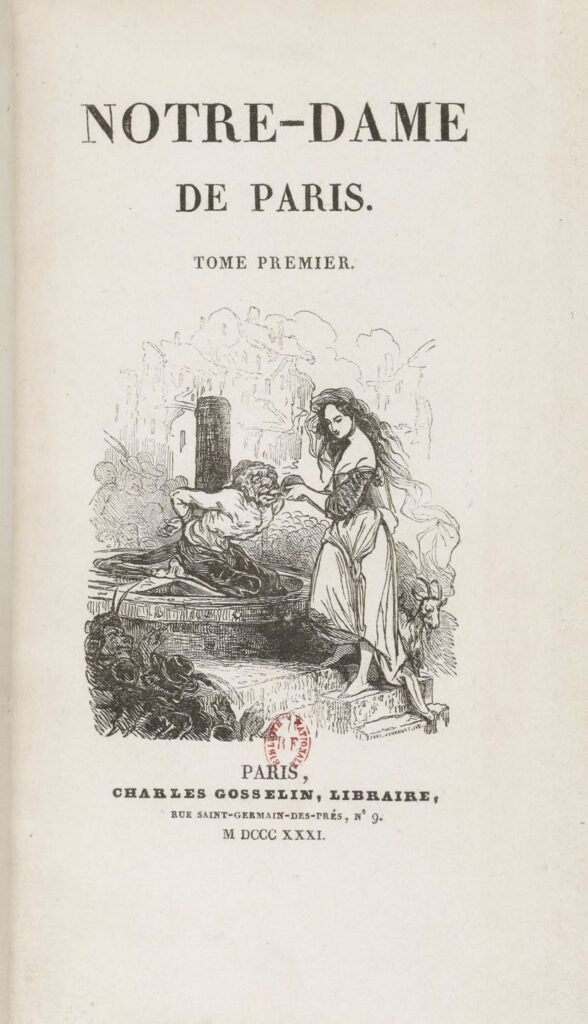(Notre-Dame de Paris)
Victor Hugo
1831
(Love for a young gypsy woman allows an ugly man to rise above the world’s hatred of him, and to show his inner beauty).

Beauty and beast stories are thousands of years old. Here is how they generally go: a beautiful maiden somehow must associate with a character of less-than-alluring appearance, such as an animal, a god in disguise, or a magically uglified human. The girl eventually sees beyond the grotesque exterior to the real person inside, and falls in love. Then very often the whole moral is promptly compromised by the male character’s transformation into the handsome prince. Ah—it’s really about outward appearance (and wealth) after all! I write this with a smirk, as in fact those stories are not claiming that outward appearance should have no importance, but just that love can be demonstrated to be rooted in deeper things if we remove good looks as an experiment. (By the way, we’re generally talking here about removing the man’s good looks. Removing the woman’s good looks is far rarer in literature, as any student of human behavior could have predicted.)
Victor Hugo, perhaps the wisest of the great French novelists, wrote the perfect beauty and beast story—indeed, could do so only because he was wise. He understood beauty and was true to it in all its manifestations; and he understood ugliness and was fearless and trenchant in portraying its effects and implications. The novel is fundamentally about beauty: of Notre Dame cathedral, of Quasimodo its deaf mutant bell-ringer, of Esmeralda the gypsy girl. The beauty is very different in the three examples, except in fragility, which they share—these three beautiful things, a building, a beast, and a belle. And their fragility is due to ugliness, which likewise takes diverse forms.
 As only a great novel can, The Hunchback of Notre-Dame crafts a grand philosophical message without ever seeming to do so. In this case it explores the overlap between aesthetics and morality: the behavior, psychology, and values of humans in interaction with beauty. One can even get quantitative about the whole thing and draw a 2×2 table and place the main characters according to the presence and absence of inner beauty (personality, character, values) vs. outer beauty (appearance, attractiveness). At the heart of the book are the two people with inner beauty. Esmeralda is the gypsy dancing girl of sixteen with the raven hair and emerald eyes. She is innocent and open, lovely and loving. She is beautiful inside and out, as our table would have it, and the only such character in the novel. Then we have Quasimodo, the abandoned hunchback who is adopted by the Archdeacon of the cathedral, and over the years has in a sense become one with the sacred building. His external deformities have caused the world to alienate him, despite his capacity for deep love and supreme self-sacrifice. In contrast to these two characters with internal beauty we have two others without it. One is Claude Frollo, Archdeacon of Notre Dame, whose ugly insides ooze through his demeanor and appearance such that he is called the “goblin monk”. But didn’t he teach Quasimodo sign language? And adopt him in the first place? Yes, but despite some virtue there are many ways to be ugly inside. His cruel lack of compassion for his foster-son and Esmeralda at the times of their greatest need was more than enough demonstration of his corrupted heart. Then we have Phoebus– Captain Phoebus de Châteaupers, the handsome womanizer with whom Esmeralda is infatuated. His superficial comeliness becomes disgusting when joined with his selfish, wanton personality. Quasimodo himself strikingly illustrates the difference between himself and Phoebus with the symbolism of two flowerpots he places in Esmeralda’s room (ch.46). One is a stunning crystal vase, but is broken and contains only brown dead flowers. The other is a modest clay pot, but bursts with colorful and fragrant blooms.
As only a great novel can, The Hunchback of Notre-Dame crafts a grand philosophical message without ever seeming to do so. In this case it explores the overlap between aesthetics and morality: the behavior, psychology, and values of humans in interaction with beauty. One can even get quantitative about the whole thing and draw a 2×2 table and place the main characters according to the presence and absence of inner beauty (personality, character, values) vs. outer beauty (appearance, attractiveness). At the heart of the book are the two people with inner beauty. Esmeralda is the gypsy dancing girl of sixteen with the raven hair and emerald eyes. She is innocent and open, lovely and loving. She is beautiful inside and out, as our table would have it, and the only such character in the novel. Then we have Quasimodo, the abandoned hunchback who is adopted by the Archdeacon of the cathedral, and over the years has in a sense become one with the sacred building. His external deformities have caused the world to alienate him, despite his capacity for deep love and supreme self-sacrifice. In contrast to these two characters with internal beauty we have two others without it. One is Claude Frollo, Archdeacon of Notre Dame, whose ugly insides ooze through his demeanor and appearance such that he is called the “goblin monk”. But didn’t he teach Quasimodo sign language? And adopt him in the first place? Yes, but despite some virtue there are many ways to be ugly inside. His cruel lack of compassion for his foster-son and Esmeralda at the times of their greatest need was more than enough demonstration of his corrupted heart. Then we have Phoebus– Captain Phoebus de Châteaupers, the handsome womanizer with whom Esmeralda is infatuated. His superficial comeliness becomes disgusting when joined with his selfish, wanton personality. Quasimodo himself strikingly illustrates the difference between himself and Phoebus with the symbolism of two flowerpots he places in Esmeralda’s room (ch.46). One is a stunning crystal vase, but is broken and contains only brown dead flowers. The other is a modest clay pot, but bursts with colorful and fragrant blooms.
Environing the beautiful with the ugly demonstrates Hugo’s fascination with the way in which contrast can set something in sharp relief, and thus increase its salience or poignancy. Quasimodo is this effect incarnate, of course. Esmeralda exhibits it also, being herself a bright spot surrounded by the darkness produced by her suitors. How could Esmeralda be so easily humiliated and cast aside, despite being in the affections of so many? Many beautiful women know of this strange dichotomy, this terrible ambivalence inherent in the sort of “love” to which they have been… subjected. All of the significant male characters in the novel are “in love” with Esmeralda; but as for what this means for her we must be brutally honest. Aside from the unspoken devotion of Quasimodo, what passes for love otherwise is viciously grasping, spiteful, and on the verge of hate (Frollo); or distracted and neglectful (Gringoire); or gaudy, inauthentic, and short-lived (Phoebus). It is surprising, though strangely idealistic, that we use the same word (in both English and French, though not in all languages) for a sexual attachment, a momentary spark of emotion, and true and lasting devoted love.
So far we have given short shrift to a central character, perhaps the central character of the novel: the cathedral itself. The original title of the novel was in fact Notre-Dame de Paris, “Our Lady of Paris”, involving Esmeralda and the cathedral in a double meaning (or triple, if you count Mary, after whom the cathedral was named). Frederic Shoberl, when he translated the novel into English two years after it was published, titled it The Hunchback of Notre-Dame, thus placing Quasimodo at the fore; this title has stuck for the English readership ever since. Nevertheless, literary criticism has long maintained the cathedral as the central feature of the book, for good reasons both intrinsic and extrinsic to the text. Hugo himself, though only in his twenties when he wrote this novel, was already known for his complex and ambivalent views about the nature of cultural progress, at least as it was proceeding in nineteenth century western Europe. Notre Dame Cathedral was a potent symbol of what he thought was wrong with modernization. The Gothic beauty had fallen into disrepair, and over time the wonderful medieval architecture was being replaced with additions that were either jarringly and anachronistically neoclassical, or else bereft of any style. His descriptions of the cathedral and of Paris were remarkably vivid, enough so to stir the emotions of the French people as perhaps only living characters had done before. Thus they read Notre-Dame de Paris as at least partly a social comment novel, a call to action. In response, they started a revolution—a bloodless one this time, thankfully– a Gothic revival movement, that led to a respectful restoration of the cathedral beginning in the 1840s.
Testament to the author’s dramatic and imaginative power, the cathedral itself participates fully in the central themes manifested by the other characters. It is a beautiful, stately, unimpeachable figure, but surrounded and threatened by ugliness and depravity: the judicial system, the bourgeoisie, the royalty, the very street. And just as cruelty threatens Esmeralda and Quasimodo even as it sets off their varied beauties, likewise cruelty besieges and endangers Notre Dame. The gypsies attack it, the king violates its role as Sanctuary, and its creepy Archdeacon misuses it as a lair and would-be prison.
Thus, three beautiful characters lead the novel. All are silent in the end, although truly none of our trinity of heroes has said much all along, and that is to their credit. But what will become of the Cathedral? It alone remains: gray, Gothic, observant but aloof, injured but stalwart. In The Hunchback of Notre-Dame we have no magical transformations, no unrealistic erasure of ugliness, no happily ever after: no compromising of the moral. Rather, we have beauty remaining beautiful until it is undervalued and destroyed.
(Epilogue:)
Two recent events have brought this novel back into the limelight. The first and minor of these is that in 2010 research by Adrian Glew in the Tate Archives uncovered the mention of a stonemason at Notre Dame around the time Hugo was writing his novel. An English sculptor Henry Sibson, who was working on repairs to Notre Dame in the 1820s, wrote in his memoirs of this mason, who was kind but somewhat reclusive, and who was only known by his physical deformity, Le Bossu (The Hunchback), “a nickname given to him and I scarcely ever heard any other”. Thus Quasimodo appears to have been based on a historical figure, although it took nearly two centuries for us to find out.
Secondly, and sadly, Notre Dame Cathedral was ravaged by a terrible fire on 15 April 2019, which destroyed much of the timber roof above the cathedral’s vault, as well as the distinctive flèche, the lead-covered wooden spire, that rose in the center. (In an eerie coincidence, I began reviewing this novel in preparation for this reflection on April 14, a day before the fire broke out.) The French have committed to rebuilding, and the world has responded with financial support. As I write today on 16 June 2019, the cathedral is celebrating its first mass since the blaze, amid debris and beneath a still precarious vault. In his remarks today, Archbishop Michel Aupetit emphasized the “singular purpose” of Notre Dame de Paris as a place of worship; but after reflecting on the novel of the same name, I could not help but think that both objects are equally well described by the priest’s subsequent reference to the building as “the fruit of human genius, a masterpiece of man”.
Summary
Book I: The setting is Paris in 1482, during the reign of Louis XI. An aspiring dramatist Pierre Gringoire is foiled in his presentation of a mystery play to the Parisian people, by several distractions. The culminating one is a face-making match where the monstrous, deaf, one-eyed mutant Quasimodo wins first prize. This orphaned bell-ringer of Notre Dame Cathedral is then taken through the streets of Paris and hailed in ridicule as the king of the ugly face: the Pope of Fools. Meanwhile the beautiful “Egyptian” dancing girl Esmeralda and her little white goat Djali make admirers of the people.
Book II: The frustrated poet Gringoire now finds himself at the torturous Place de Grève, where Quasimodo and the following train of jubilant fun-pokers meets Claude Frollo, Archdeacon of the Cathedral and Quasimodo’s foster father. Gringoire, enchanted by Esmeralda and her goat, follows her, and sees Quasimodo mysteriously attempt to abduct the girl (by the secret orders of the lustful Frollo). A Captain Phoebus saves her, and she is taken back home by her people, a band of violent gypsies. Gringoire is taken by them too, however, and is about to be killed when Esmeralda, in keeping with gypsy custom, agrees to marry him in order to save him. It is a platonic marriage however, Gringoire being more in love with the goat than with Esmeralda.
Book III: Notre Dame Cathedral is described, including its architecture and the ravages of time and people. Hugo presents a bird’s-eye view of Paris, interspersed with his reflections on the city. An interesting if initially curious addition to this novel, one particular chapter provides a glimpse into what the cathedral and the town must have been like at the time the story is set.
Book IV: A short history is provided of Claude Frollo and of Quasimodo, the latter a strong, misshapen, but inwardly beautiful creature. He lives and feels at home in the belfry of the cathedral, although his job of ringing the cathedral’s bells has made him deaf. He feels enormous gratitude to Frollo for taking him in.
Book V: Hugo gives us a trenchant parody and satire on the French judiciary in the medieval era. Quasimodo stands trial for attempted abduction, and is taken for public torture at the Place de Grève. Watching this spectacle is a crazed woman who lives in self-imposed seclusion in a cell next to the square. She lost her infant child Agnes sixteen years ago to gypsies who replaced it with a mutant thing (Quasimodo). This woman hates gypsies, and the girl Esmeralda especially; and she dotes over a shoe, which is all she still possesses of her lost baby girl. Esmeralda, who herself is the subject of public scorn as a sorceress, goes to Quasimodo in the midst of his suffering, and gives him a drink.
Book VI: Esmeralda is publicly introduced to her savior and (since then) crush, Captain Phoebus, who is a superficial womanizer. Archdeacon Frollo, who loves Esmeralda with a selfish and scary passion, coaxes Captain Phoebus to court Esmeralda in his presence. As the Captain is doing his best to woo the girl, Frollo stabs him in jealousy, he thinks to death. Esmeralda is blamed for the stabbing.
Book VII: Esmeralda falsely confesses to the stabbing under torture, and is thrown into prison, condemned to die. Claude Frollo comes to her and promises her amnesty if she will have him. She refuses, wishing to die rather than be with the lecherous priest. She, meanwhile, thinks only of Phoebus– who thinks no more of her although he is very much alive. As Esmeralda is taken to be hung, Quasimodo rescues her to Notre Dame, yelling “Sanctuary!”. The people cheer at the romance of it all, and she lives in the cathedral for a while.
Book VIII: Quasimodo and Esmeralda get to know each other gradually, the beauty of one and the ugliness of the other taking time to coexist. Quasimodo serves her faithfully, and is hurt when she notices Phoebus in a window across the square and yearns for him. The bell-ringer is still devoted, however, and mediates between them although Phoebus desires no more of her company. Meanwhile, Frollo attempts either to persuade Esmeralda to have him, or to kill her. Quasimodo is torn between the two objects of his devotion, and at one point saves Esmeralda’s life from the hand of his foster father.
Book IX: Gringoire (the artist and Esmeralda’s platonic “husband”) and the gypsies are worried that the sanctuary custom will not be upheld by the government, and that Esmeralda will be taken even from a church. Gringoire conceives a plot, and convinces the gypsies to besiege Notre Dame and take Esmeralda. Claude Frollo’s wastrel brother Jehan, whom we have seen in the court, joins up with the gypsies as well. They march into the plaza of Notre Dame and attempt to enter the church. Quasimodo, fearful for Esmeralda’s safety, mounts a single-handed campaign against them with rocks, beams, and molten lead from the cathedral towers. The King happens to be nearby during this event, and is convinced to repeal the sanctuary custom and to send men to save Notre Dame from the vagabonds who are destroying it. Gringoire is arrested for being one of the uprisers, appeals (amusingly) for clemency to the King, and is granted it. Meanwhile Quasimodo, having defeated the entire army of invaders, returns to check on his ward, and finds her missing.
Download this SPOILER if you want the ending revealed
Tidbits of Significance
(Translated from the French by Frederic Shoberl, except for those marked “IFH”, which are translated by Isabel F. Hapgood. In a footnote to his 1833 Introduction, Shoberl quotes a “critic of the Athenaeum” as follows:
“Few Englishmen are able to read the writings of Victor Hugo with facility in the original, for the author has not merely a style but a language of his own. The truth is, he has culled from all ages and all ranks, and from every era of French literature, words and expressions wherewith to embody forth the strange creations of his powerful imagination; and his language laughs to scorn the authority of the Académie, the Institut, and the lexicographers.”
This critic’s impression undoubtedly reminds us of a particular English playwright who is famous for the very same thing, and indeed the French poet and historian Alphonse de Lamartine called Hugo “The Shakespeare of prose fiction” (The New Oxford Companion to Literature in French). Anyway, our English translator Shoberl leaves us with the promise that “it has been his aim in the task to preserve as much as possible the peculiarities of the author’s style and manner”, except that he softens some crude expressions.)
It is this day three hundred and forty-eight years six months and nineteen days since the good people of Paris were awakened by a grand peal from all the bells in the three districts of the Cité, the Université, and the Ville.
-Bk.I, ch.1 (first sentence). [The occasion was one particular annual Festival of Fools, at which Quasimodo would end up being the Pope of Fools.]
Supposing the entity of the poet to be represented by the number 10; it is certain that a chemist, on analysing it, would find it to be composed of one part interest and nine parts vanity.
-Bk.I, ch.1.
Nothing renders one so adventurous as not being able to feel the place where one’s pocket is situated.
-Bk.II, ch.6 (IFH). Sometimes translated without the circumlocution, simply “…as an empty pocket”.
You have been a child, reader, and may perhaps have the good fortune to be so still. I dare say you have often (I know I have, for whole days together, ay, and some of the best-spent days of my life) followed from bush to bush on the bank of a stream, on a fine sunshiny day, some beautiful green-and-blue dragon-fly, darting off every moment at acute angles, and brushing the ends of all the branches. You remember with what ardent curiosity your attention and your eyes were fixed on those fluttering wings of purple and azure, amid which floated a form rendered indistinct by the very rapidity of its motion. The aerial creature, confusedly perceived through this flickering of wings, appeared to you chimerical, imaginary, a thing neither to be touched nor seen. But when at length it settled on the point of a rush, and, holding your breath the while, you could examine those delicate wings of gauze, that long robe of enamel, those two globes of crystal, what astonishment did you not feel, and what fear lest this beautiful figure should again vanish into an airy undefinable phantom! Recollect these impressions, and you will easily conceive what Gringoire felt on contemplating in a visible and palpable form that Esmeralda of whom he had till then had but a glimpse amid the whirling dance and a crowd of spectators.
-Bk.II, ch.7.
…the grandest productions of architecture are not so much individual as social works, rather the offspring of nations in labour than the inventions of genius; the deposit left by a people; the accumulations formed by ages; the residuum of the successive evaporations of human society– in short, a species of formation. Every wave of time superinduces its alluvium, every generation deposits its stratum upon the structure, every individual brings his stone. Such is the process of the beavers, such that of the bees, such that of men. The great emblem of architecture, Babel, is a beehive.
Great buildings, like great mountains, are the work of centuries.
-Bk.III, ch.1.
…one can be a fine genius, and yet understand nothing of an art to which one does not belong.
-Bk.III, ch.2. (IFH). [He uses Voltaire as an example. Sometimes the final bit is translated with the possession reversed, i.e. “an art one does not have”, which might make more sense in English.]
Our fathers had a Paris of stone; our children will have a Paris of plaster.
-Bk.III, ch.2.
…life without love is but a dry wheel, creaking and grating as it revolves.
-Bk.IV, ch.2.
Now we have remarked that judges in general arrange matters so that the days on which they have to perform their judicial functions are their days of ill-humour, that they may be sure to have somebody on whom they can conveniently vent it in the name of the King, of the law, and of justice.
-Bk.V, ch.1.
Solus cum sola non cogitabantur orare Paternoster.
-Bk.VI, ch.2. [“A man and a maid together don’t think about saying the ‘Our Father’”)].
…how furiously this sea of human passions ferments and boils when it is refused any outlet; how it swells, how it rises, how it overflows; how it heaves in inward convulsions, till it has broken down its dikes and burst its bed.
-Bk.VI, ch.4.
Quasimodo paused under the great porch. His large feet seemed as firmly rooted in the pavement of the church as the massive Roman pillars. His huge head, with its profuse covering of hair, appeared to be thrust down into his shoulders, like that of the lion, which too has a copious mane and no neck. He held the damsel, palpitating all over, hanging from his horny hands like a white drapery; but he carried her with as much care as if he was fearful of bruising or disturbing her. He felt, you would have thought, that a thing so delicate, so exquisite, so precious, was not made for such hands as his. At times he looked as though he dared not touch her even with his breath. Then, all at once, he would clasp her closely in his arms, against his angular bosom, as his treasure, as his all, as the mother of that girl would herself have done. His Cyclops eye bent down upon her, shed over her a flood of tenderness, of pity, of grief, and was suddenly raised flashing lightning. At this sight the women laughed and cried; the crowd stamped with enthusiasm, for at that moment Quasimodo was really beautiful.
-Bk.VII, ch.6.
And as he thus sifted his soul to the bottom, when he perceived how large a space nature had prepared there for the passions, he sneered still more bitterly. He stirred up in the depths of his heart all his hatred, all his malevolence; and, with the cold glance of a physician who examines a patient, he recognized the fact that this malevolence was nothing but vitiated love; that love, that source of every virtue in man, turned to horrible things in the heart of a priest, and that a man constituted like himself, in making himself a priest, made himself a demon.
-of Claude Frollo; Bk.IX, ch.1 (IFH).
How fascinating is debauchery in front, but oh! how ugly and deformed behind!
-Bk.IX, ch.2.
Love is like a tree; it sprouts forth of itself, sends its roots out deeply through our whole being, and often continues to flourish greenly over a heart in ruins. And the inexplicable point about it is that the more blind is this passion, the more tenacious it is. It is never more solid than when it has no reason in it.
-Bk.IX, ch.4 (IFH).
“When one has an idea, one encounters it in everything.”
-Gringoire, Bk.X, ch.1 (IFH).
When those who found this skeleton attempted to disengage it from that which it held in its grasp it crumbled to dust.
-Bk.X, ch.4 (last sentence).
Tips
READ THIS WHEN…
…you want to gain an appreciation for inner beauty, and its thoroughly unpredictable relation to outer beauty
or,
you are in the mood for a dark romance set in old Paris around the imposing medieval cathedral of Notre Dame.
IF YOU LIKE THIS, YOU’D LIKE:
(For the aesthete:)
- Plato, Symposium (5th cent. B.C.)
- Ralph Waldo Emerson, ‘Beauty’ (1860)
- Thomas Hardy, Far from the Madding Crowd (1874)
- Antoine de Saint Exupéry, The Little Prince (1943)
(For the romantic Gallophile:)
- Jean-Jacques Rousseau, Julie (1761)
- Jacques-Henri Bernardin de Saint-Pierre, Paul and Virginia (1788)
- François-René Chateaubriand, Atala (1801)
- Théophile Gautier, Mademoiselle de Maupin (1835)
Find It!
Hardcover: The reliable Everyman edition.
Paperback: This Penguin edition translated by John Sturrock has been in print since 1978.












The irony is that the Cathedral of Notre Dame, beautiful and neglected in 1482, remains beautiful and neglected in 2019. After the great fire of 6 months ago, a number of French billionaires stepped up to offer billions for reconstruction. But the Yellow Jackets of France, perhaps representing the common man, insisted the money should have been used instead as handouts to the People. It’s not even a matter of asking the People to pay out of their own pockets. Rather, it’s saying that the great cultural achievement of the Cathedral is less important than a rise in personal income.
I would argue that a similar argument is playing out here. New York City has the honor of hosting a number of elite high schools, whose graduates have a stunning record of achievement in science and other fields. The 3 oldest schools (Bronx High School of Science, Stuyvesant, Brooklyn Tech) have between them produced 14 Nobel Prize winners. Bronx High School of Science alone accounts for 8 of these, more than any other high school in the world and more than entire countries like China, India, Argentina, Spain, Norway and hundreds of others. Admission is by a single competitive exam. Mayor de Blasio would abolish the exam in order to achieve a racial breakdown among the student body more reflective of the City. Perhaps a broader segment of the city population would feel good about themselves, but an academic miracle would be extinguished.
Very powerful statement and connection, Uldis– thank you for that! It reminds me of learning (from a tour guide) that the imperial Winter Palace in St. Petersburg was almost completely destroyed in the name of “the people” in 1917 or thereafter. Today we would not have the Hermitage if that had happened.